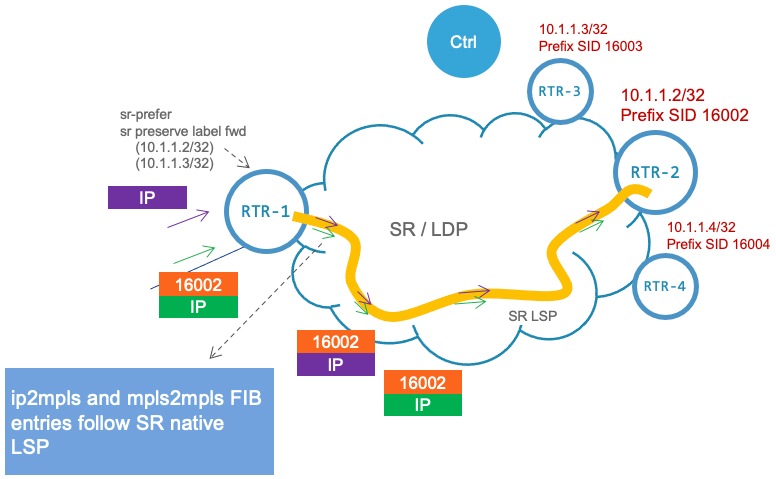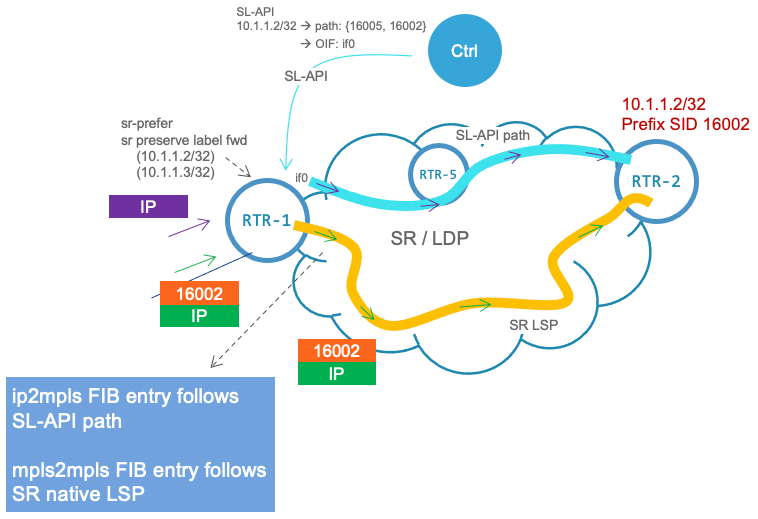Verification
Consider the following SR prefix as allowed to be steered over an SL-API path:
-
Prefix: 10.1.1.1/32
-
Prefix SID: 20000
The SR native LSP programmed at a node in the network is as follows:
-
Local label: 20000
-
ECMP:
-
Path0 – out label: 20000; out int: Bundle-Ether20131
-
Path1 – out label: 20000; out int: Bundle-Ether20132
-
Path2 – out label: 20000; out int: Bundle-Ether20133
-
Path3 – out label: 20000; out int: Bundle-Ether20134
The SL-API LSP to be programmed by the controller at the same node is as follows:
The following sequence of show command outputs can be used to verify the programming of the imposition forwarding entry when
an SL-API path is present.
The following output shows the RIB entry for an allowed prefix highlighting the fields to indicate that overriding of MPLS
label imposition via SL-API is enabled:
Router# show route 10.1.1.1/32 detail
Routing entry for 10.1.1.1/32
Known via "isis 0", distance 115, metric 500, labeled SR (label forwarding preserve), type level-2
Installed Jul 30 21:23:50.539 for 01:43:09
Routing Descriptor Blocks
100.201.201.2, from 199.1.0.2, via Bundle-Ether20131
Route metric is 500
Label: 0x4e20 (20000)
Tunnel ID: None
Binding Label: None
Extended communities count: 0
Path id:4 Path ref count:0
NHID:0x0(Ref:0)
MPLS eid:0x109c700000001
101.201.201.2, from 199.1.0.2, via Bundle-Ether20132
Route metric is 500
Label: 0x4e20 (20000)
Tunnel ID: None
Binding Label: None
Extended communities count: 0
Path id:3 Path ref count:0
NHID:0x0(Ref:0)
MPLS eid:0x109c700000001
102.201.201.2, from 199.1.0.2, via Bundle-Ether20133
Route metric is 500
Label: 0x4e20 (20000)
Tunnel ID: None
Binding Label: None
Extended communities count: 0
Path id:2 Path ref count:0
NHID:0x0(Ref:0)
MPLS eid:0x109c700000001
103.201.201.2, from 199.1.0.2, via Bundle-Ether20134
Route metric is 500
Label: 0x4e20 (20000)
Tunnel ID: None
Binding Label: None
Extended communities count: 0
Path id:1 Path ref count:0
NHID:0x0(Ref:0)
MPLS eid:0x109c700000001
Route version is 0x47 (71)
Local Label: 0x4e20 (20000)
IP Precedence: Not Set
QoS Group ID: Not Set
Flow-tag: Not Set
Fwd-class: Not Set
Route Priority: RIB_PRIORITY_NON_RECURSIVE_MEDIUM (7) SVD Type RIB_SVD_TYPE_LOCAL
Download Priority 1, Download Version 1793240
Route eid: 0x109c700000001
No advertising protos.
The following output shows the imposition forwarding entry programmed via SL-API (rewrite owner) in LSD. Observe the programmed
paths and their parameters (output interface, output labels, and weight).
Router# show mpls lsd forwarding ipv4 detail | begin 10.1.1.1/32
'default':4U, 10.1.1.1/32, (100051)[SR Merge], 4 Paths,
Owner=Static(A):Service-layer
1/4: IPv4_STACK, 'default':4U, BE2012, BSID: NO_LABEL, nh=100.201.200.2, lbls={ 24000, 18001 }
lbl flags= {0x0 0x0} ()}, ext_flags=0x0 path_flags=0x0
nh-id=0x0, path-id=0, backup-path-id=0, load-metric=32, parent-intf=None, path-set-id=0, path-priority=0
Inner Stack Flags: { 0x0}
MPLS eid: N/A
2/4: IPv4_STACK, 'default':4U, BE2013, BSID: NO_LABEL, nh=101.201.200.2, lbls={ 24000, 18001 }
lbl flags= {0x0 0x0} ()}, ext_flags=0x0 path_flags=0x0
nh-id=0x0, path-id=0, backup-path-id=0, load-metric=64, parent-intf=None, path-set-id=0, path-priority=0
Inner Stack Flags: { 0x0}
MPLS eid: N/A
3/4: IPv4_STACK, 'default':4U, BE2014, BSID: NO_LABEL, nh=102.201.200.2, lbls={ 24001, 18001 }
lbl flags= {0x0 0x0} ()}, ext_flags=0x0 path_flags=0x0
nh-id=0x0, path-id=0, backup-path-id=0, load-metric=128, parent-intf=None, path-set-id=0, path-priority=0
Inner Stack Flags: { 0x0}
MPLS eid: N/A
4/4: IPv4_STACK, 'default':4U, BE2015, BSID: NO_LABEL, nh=103.201.200.2, lbls={ 24001, 18001 }
lbl flags= {0x0 0x0} ()}, ext_flags=0x0 path_flags=0x0
nh-id=0x0, path-id=0, backup-path-id=0, load-metric=256, parent-intf=None, path-set-id=0, path-priority=0
Inner Stack Flags: { 0x0}
MPLS eid: N/A
BCDL priority:1, LSD queue:9, version:178429,
flags: 0x8, fwd_flags: 0x100 (sr_lbl_fwd_preserve),
Installed Jul 30 21:26:25.111 (01:42:45 ago)
Prefix eid: 0x1275100000001
. . .
The following output shows that the CEF imposition forwarding entry prefers the SL-API path.
Router# show cef 10.1.1.1/32 detail location 0/0/CPU0
10.1.1.1/32, version 178429, internal 0x1000001 0x110 (ptr 0xa0ea1428) [3], 0x0 (0x1182a378), 0xa28 (0x202c3ba8)
Updated Jul 30 21:26:25.635
local adjacency to Bundle-Ether2012
Prefix Len 32, traffic index 0, precedence n/a, priority 1, encap-id 0x1275100000001
gateway array (0x1d140ef8) reference count 750, flags 0x68, source lsd (5), 1 backups
[251 type 5 flags 0x8401 (0x8c18bda0) ext 0x0 (0x0)]
LW-LDI[type=5, refc=3, ptr=0x1182a378, sh-ldi=0x8c18bda0]
gateway array update type-time 1 Jul 30 21:26:25.532
LDI Update time Jul 30 21:26:25.532
LW-LDI-TS Jul 30 21:26:25.635
via 100.201.200.2/32, Bundle-Ether2012, 7 dependencies, weight 32, class 0 [flags 0x0]
path-idx 0 NHID 0x0 [0x90fa8028 0x0]
next hop 100.201.200.2/32
local adjacency
local label 100051 labels imposed {24000 18001}
via 101.201.200.2/32, Bundle-Ether2013, 7 dependencies, weight 64, class 0 [flags 0x0]
path-idx 1 NHID 0x0 [0x90fa85c8 0x0]
next hop 101.201.200.2/32
local adjacency
local label 100051 labels imposed {24000 18001}
via 102.201.200.2/32, Bundle-Ether2014, 7 dependencies, weight 128, class 0 [flags 0x0]
path-idx 2 NHID 0x0 [0x90fa82f8 0x0]
next hop 102.201.200.2/32
local adjacency
local label 100051 labels imposed {24001 18001}
via 103.201.200.2/32, Bundle-Ether2015, 7 dependencies, weight 256, class 0 [flags 0x0]
path-idx 3 NHID 0x0 [0x90fa8190 0x0]
next hop 103.201.200.2/32
local adjacency
local label 100051 labels imposed {24001 18001}
Weight distribution:
slot 0, weight 32, normalized_weight 1, class 0
slot 1, weight 64, normalized_weight 2, class 0
slot 2, weight 128, normalized_weight 4, class 0
slot 3, weight 256, normalized_weight 8, class 0
Load distribution: 0 1 1 2 2 2 2 3 3 3 3 3 3 3 3 (refcount 251)
Hash OK Interface Address
0 Y Bundle-Ether2012 100.201.200.2
1 Y Bundle-Ether2013 101.201.200.2
2 Y Bundle-Ether2013 101.201.200.2
3 Y Bundle-Ether2014 102.201.200.2
4 Y Bundle-Ether2014 102.201.200.2
5 Y Bundle-Ether2014 102.201.200.2
6 Y Bundle-Ether2014 102.201.200.2
7 Y Bundle-Ether2015 103.201.200.2
8 Y Bundle-Ether2015 103.201.200.2
9 Y Bundle-Ether2015 103.201.200.2
10 Y Bundle-Ether2015 103.201.200.2
11 Y Bundle-Ether2015 103.201.200.2
12 Y Bundle-Ether2015 103.201.200.2
13 Y Bundle-Ether2015 103.201.200.2
14 Y Bundle-Ether2015 103.201.200.2
The following output shows the backup CEF imposition forwarding entry if the SL-API path is not present. Observe that it follows
the SR native LSP.
Router# show cef 10.1.1.1/32 backup detail location 0/0/CPU0
10.1.1.1/32, version 1793240, priority 1, flags 0x200000, flags2 0x81, extn_flags 0x2100, source rib (7), ctx-flags 0xc1
Updated Jul 30 21:23:50.819
Prefix Len 32
Label count = 1, src = 7, label = 20000
via BE20131 (0xf013954) 100.201.201.2, weight 0, class 0 [flags 0x0]
next hop VRF - 'default', table - 0xe0000000
Output labels {20000}
via BE20132 (0xf01395c) 101.201.201.2, weight 0, class 0 [flags 0x0]
next hop VRF - 'default', table - 0xe0000000
Output labels {20000}
via BE20133 (0xf013964) 102.201.201.2, weight 0, class 0 [flags 0x0]
next hop VRF - 'default', table - 0xe0000000
Output labels {20000}
via BE20134 (0xf01396c) 103.201.201.2, weight 0, class 0 [flags 0x0]
next hop VRF - 'default', table - 0xe0000000
Output labels {20000}
The following output shows the labeled forwarding entry (MPLS-to-MPLS) for the SR prefix SID local label (20000). Observe
that it follows the SR native LSP.
Router# show mpls forwarding labels 20000 location 0/0/CPU0
Local Outgoing Prefix Outgoing Next Hop Bytes
Label Label or ID Interface Switched
------ ----------- ------------------ ------------ --------------- ------------
20000 20000 SR Pfx (idx 4000) BE20131 100.201.201.2 0
20000 SR Pfx (idx 4000) BE20132 101.201.201.2 0
20000 SR Pfx (idx 4000) BE20133 102.201.201.2 0
20000 SR Pfx (idx 4000) BE20134 103.201.201.2 0
The following output shows the details for the labeled forwarding entry (MPLS-to-MPLS) for the SR prefix SID local label (20000).
Router# show mpls forwarding labels 20000 detail location 0/0/CPU0
Local Outgoing Prefix Outgoing Next Hop Bytes
Label Label or ID Interface Switched
------ ----------- ------------------ ------------ --------------- ------------
20000 20000 SR Pfx (idx 4000) BE20131 100.201.201.2 0
Updated: Jul 30 21:26:25.158
Version: 1793240, Priority: 15
Label Stack (Top -> Bottom): { 20000 }
NHID: 0x0, Encap-ID: N/A, Path idx: 0, Backup path idx: 0, Weight: 0
MAC/Encaps: 14/18, MTU: 1500
Outgoing Interface: Bundle-Ether20131 (ifhandle 0x0f013954)
Packets Switched: 0
20000 SR Pfx (idx 4000) BE20132 101.201.201.2 0
Updated: Jul 30 21:26:25.158
Version: 1793240, Priority: 15
Label Stack (Top -> Bottom): { 20000 }
NHID: 0x0, Encap-ID: N/A, Path idx: 1, Backup path idx: 0, Weight: 0
MAC/Encaps: 14/18, MTU: 1500
Outgoing Interface: Bundle-Ether20132 (ifhandle 0x0f01395c)
Packets Switched: 0
20000 SR Pfx (idx 4000) BE20133 102.201.201.2 0
Updated: Jul 30 21:26:25.158
Version: 1793240, Priority: 15
Label Stack (Top -> Bottom): { 20000 }
NHID: 0x0, Encap-ID: N/A, Path idx: 2, Backup path idx: 0, Weight: 0
MAC/Encaps: 14/18, MTU: 1500
Outgoing Interface: Bundle-Ether20133 (ifhandle 0x0f013964)
Packets Switched: 0
20000 SR Pfx (idx 4000) BE20134 103.201.201.2 0
Updated: Jul 30 21:26:25.158
Version: 1793240, Priority: 15
Label Stack (Top -> Bottom): { 20000 }
NHID: 0x0, Encap-ID: N/A, Path idx: 3, Backup path idx: 0, Weight: 0
MAC/Encaps: 14/18, MTU: 1500
Outgoing Interface: Bundle-Ether20134 (ifhandle 0x0f01396c)
Packets Switched: 0
Traffic-Matrix Packets/Bytes Switched: 0/0




 Feedback
Feedback